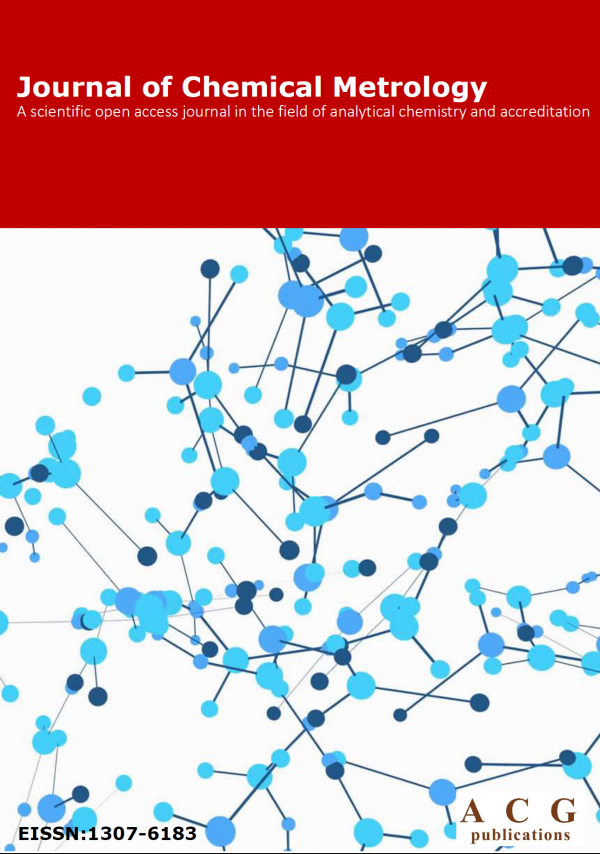Journal of Chemical Metrology
Year: 2024 Volume: 18 Issue:2 July-December
1) The impact of mineral composition on the yield and preservation of selected fatty acids in replicate archeological ceramics

The process by which clay influences the preservation and retention of absorbed lipids in archaeological pottery is not well understood. Although properties such as porosity and calcium content are frequently suggested as primary factors in lipid retention, their exact influence remains unclear. To investigate this, replicate clay ceramics were manufactured using varying proportions of illitic/illite-smectitic clay, mixed with two different tempers (sand and chalk), and fired at 800°C in an oxidizing atmosphere. This study aimed to assess the impact of these compositional variations on the preservation and retention of selected fatty acids, palmitic acid (C16:0) and oleic acid (C18:1), often discovered in archaeological lipid residue analysis, in both heat-degraded (100°C for 14 h) and undegraded forms. Gas chromatography-mass spectrometry (GC-MS) was used for quantification, employing calibration curves generated from standard solutions of fatty acid methyl esters (FAME). Two methylation techniques were utilized: acid-catalyzed methylation (ACM) and solvent extraction using a mixture of dichloromethane (DCM) and methanol (MeOH), followed by m-(trifluoromethyl)phenyltrimethylammonium hydroxide (TMTFTH) methylation. A comparison of the two techniques revealed that prior solvent extraction using a combination of DCM-MeOH may have limited the amount of C16:0 and C18:1 methylated by TMTFTH, causing inconsistent results in quantification compared to ACM. From the ACM technique, results showed that sand-tempered briquettes, whether degraded (for C16:0) or non-degraded (for C16:0 and C18:1), have minimal influence on fatty acid yield while degradation significantly affects the yield of C18:1. In contrast, C16:0 and C18:1 recovery from chalk-tempered briquettes is proportional to clay content and inversely proportional to the chalk content. This holds both for degraded and non-degraded briquettes. This work highlights the importance of considering and investigating the mineralogical composition of clay and non-clay minerals for predicting the lipid yield from ancient ceramics.
DOI http://doi.org/10.25135/jcm.117.2409.3336 Keywords Fatty acids lipid residue analysis FAME quantification derivatization methods clay porosity DETAILS PDF OF ARTICLE © 2024 ACG Publications. All rights reserved.2) Development of RP-HPLC-DAD method for quantitative analysis of quercetin and piperine in botanical extracts
.jpg)
A simple, effective, and fast reversed-phase high-performance liquid chromatographic method was devised to separate and quantitatively determine quercetin and piperine in herbal extract. the analytes were eluted on the Intersil C18 ODS column (150 mm×4.6 mm, 5μm) as a stationary phase with a gradient elution technique. The mobile phase was composed of a mixture of water (with 0.1% formic acid) and methanol (with 0.1% formic acid) and the gradient program of 30 minutes was optimized. The mobile phase flow rate was adjusted to 1 mL min-1 for 20 μL injection volume. The eluents were detected by the PDA detector at 342 nm wavelength. At the optimized chromatographic conditions, the developed method was validated for the parameters including system suitability, specificity, linearity, accuracy, precision, and robustness per the ICH Q2(R1) guidelines. The developed method was applied for the determination of quercetin and piperine in the prepared herbal extract.
DOI http://doi.org/10.25135/jcm.112.2406.3248 Keywords Herbal extract piperine quercetin RP-HPLC validation DETAILS PDF OF ARTICLE © 2024 ACG Publications. All rights reserved.3) Determination of the effect of different drying methods on secondary metabolites of Lavandula pedunculata (Mill.) Cav. subsp. cariensis (Boiss.) Upson & S. Andrews by LC-HRMS
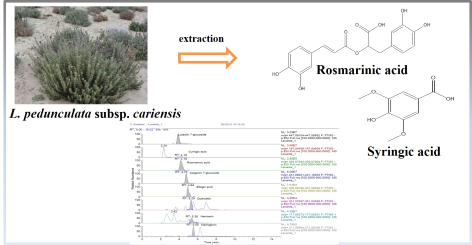
This study shows the effects of different drying methods on the secondary metabolite composition of Lavandula pedunculata (Mill.) Cav. subsp. cariensis (Boiss.) Upson & S. Andrews were evaluated. MeOH extracts of dried plants which were dried with different techniques-sun, shade, oven and microwave- were analyzed by by LC-HRMS method. The findings revealed that the amounts of phenolic substances decreased after drying compared to the fresh sample; moreover, rosmarinic acid and syringic acid were found in quite high amounts at L. pedunculata subsp. cariensis.
4) Optimization of ultrasound-assisted extraction and quantification of rutin and quercetin in Flos Styphnolobii japonici imaturi by validated UHPLC-UV method
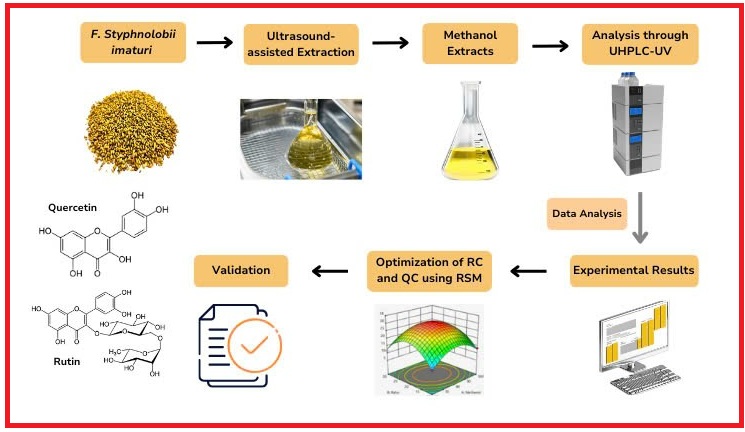
This study focuses on enhancing the extraction process of rutin and quercetin from Flos Styphnolobii japonici imaturi using ultrasound-assisted extraction (UAE) combined with response surface methodology (RSM). By analyzing 3D surface plots and performing regression analysis on the independent variables, the ideal extraction conditions were determined: 96% methanol concentration, a liquid-to-solid ratio of 19:1 (mL/g, v/w), and an ultrasound duration of 19 minutes. These optimized parameters were then applied to validate the quantification process. The bioactive compounds in the Flos Styphnolobii japonici imaturi extract were identified using ultra-high-performance liquid chromatography coupled with an ultraviolet absorption detector. This methodology was employed to quantify the rutin and quercetin content from samples collected across seven different locations in Vietnam. The results revealed that the concentrations of these compounds in the methanol extracts ranged from 0.325% to 35.73%. This study provides a scientific basis for optimizing the extraction process and contributes to the application of F. Styphnolobii imaturi in medicinal use.
DOI http://doi.org/10.25135/jcm.118.2410-3341 Keywords Flos Styphnolobii imaturi; rutin quercetin response surface methodology DETAILS PDF OF ARTICLE © 2024 ACG Publications. All rights reserved.5) Determination of secondary metabolites of Cydonia oblonga (Quince) by LC-MS/MS method together with evaluation of its antioxidant and cholinergic potentials
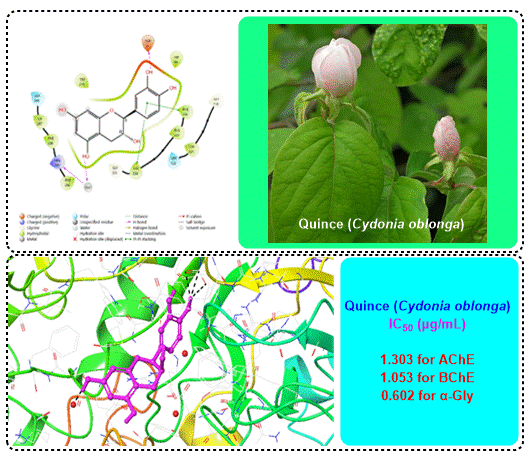
In this study, quantification of secondary metabolites of Cydonia oblonga (Quince) leaves by LC-MS/MS and antioxidant, cholinergic and α-Glycosidase activities were reported. LC-MS/MS analyses of the studied extract showed that the highest phenolic constituents of species were catechin (2024.9 ± 80.9 μg/L), vanillic acid (1121.8 ± 39.3 μg/L) and fumaric acid (486.7 ± 16.5 μg/L). The ethanol extract of quince leaves inhibited the α-glycosidase enzyme with an IC50: 0.6 μg/mL value. In order to determine the anti-Alzheimer activity of the plant extract, inhibition studies were carried out on acetylcholinesterase (AChE) and butyrylcholinesterase (BChE) enzymes. The IC50 values of the plant extract were found to be 1.3 μg/mL for AChE and 1.5 μg/mL for BChE. In addition, free radical scavenging and metal reduction tests were performed to determine the antioxidant activity of the plant and the results were compared with Trolox. It was understood that the antioxidant potential of the plant was lower than Trolox. The results from biological abilities, molecular docking of catechin hydrate as abundant phenolic compounds in quince leaves extract to be an inhibitor candidate for AChE, BChE and α-glycosidase.
DOI http://doi.org/10.25135/jcm.120.2411.3380 Keywords Quince enzyme inhibition antioxidant Alzheimer’s disease molecular docking polyphenol content. DETAILS PDF OF ARTICLE © 2024 ACG Publications. All rights reserved.6) Development of tocopherols reference material to support quality and authentication control of wheat germ oil

Wheat germ oil has the highest tocopherol content of all-natural vegetable oil. It’s used in cosmetics, pharmaceuticals, food, and dietary supplement products due to its high tocopherol content. Thus, the high marketing and nutritional values have led to an adulteration of this valuable oil. The quality and authentication control of wheat germ oil is based mainly on the quantitative determination of tocopherol concentration. Therefore, NIS has developed new candidate reference material for tocopherols in wheat germ oil to support regulatory authorities and food testing laboratories in their efforts to control oil quality and authenticity. The certification was carried out using two independent sample preparation methods in accordance with ISO 17034 and ISO Guide 35 requirements. The results indicate a sufficient homogeneity and stability of CRM for up to 12 months at 4 ℃. The traceability of the CRM to SI units was established using the direct primary method. The certified value of α-tocopherol and β-tocopherol and their corresponding expanded uncertainties (k=2.0) were found to be (2033.9±49.8 mg/kg) and (625.4±38.1 mg/kg), respectively.
DOI http://doi.org/10.25135/jcm.113.2406.3257 Keywords Wheat germ oil tocopherols value assignment primary method reference materials DETAILS PDF OF ARTICLE © 2024 ACG Publications. All rights reserved.7) A novel short-wavelength near-infrared certified reference material from dysprosium and ytterbium oxides
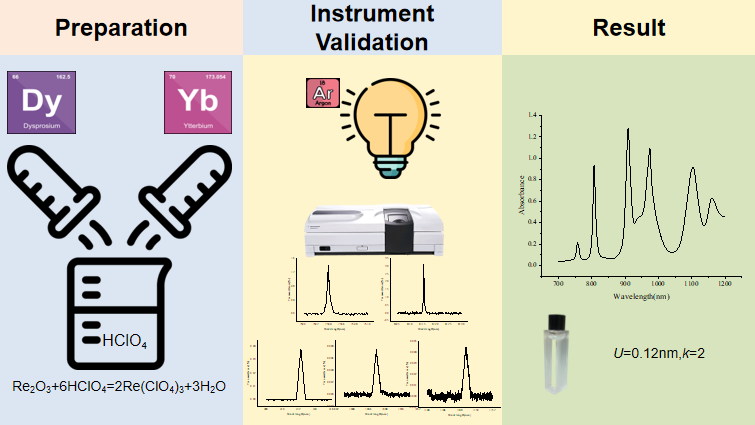
This study involves the characterization of a new shortwave NIR wavelength standard solution to address the current limitations of shortwave near infrared (NIR) standard materials and to expand the spectral wavelength range of standard materials. Herein, an innovative use of a solution of dysprosium oxide and ytterbium oxide compounds dissolved in perchloric acid solution to calibrate and verify the NIR wavelength of a high-sensitivity ultraviolet-visible-near infrared spectrophotometer is reported. This standard material enables the near infrared wavelength to be accurately traced to the theoretical emission wavelength of the elements. In the study, cubic spline interpolation was performed on the SI traceable and validated instrument for the determination of peak wavelengths. The wavelength standard values of this standard material cover the shortwave near infrared region (700~1200 nm) with an uncertainty of 0.12 nm at a 95% confidence interval.
DOI http://doi.org/10.25135/jcm.116.2409-3333 Keywords short-wavelength near-infrared argon emission lines wavelength calibration rare earth elements reference material DETAILS PDF OF ARTICLE © 2024 ACG Publications. All rights reserved.8) Patulin reference material certified by RP-HPLC-UV and gravimetry for food safety analysis

Patulin, a mycotoxin commonly found in contaminated food products, is a significant health concern and its accurate determination is of fundamental importance. The availability of a patulin reference material (RM) is a key tool for the confidence in analytical results. In this paper, a batch of patulin in 0.1% acidified acetonitrile RM was gravimetrically prepared. The prepared RM was ampouled and subjected to homogeneity, short-term, long-term stability and characterization studies by high-performance liquid chromatography with ultraviolet detection (HPLC-UV). The chromatographic separation was carried on a C-18 column using a mobile phase of ultra-pure water and acetonitrile (80:20 %) and the detection was made at 276 nm. These studies were carried out in accordance with ISO 17034 and ISO 33405. The prepared patulin reference material was found to be homogeneous and stable enough, as demonstrated by the results of the analysis of variance (ANOVA) and the regression analysis. The value assignment was based on combing data obtained by gravimetry and HPLC-UV as weighted mean and uncertainty and was found to be 26.78±1.66 mg/kg. The gravimetric preparation and value assignment of the patulin RM were validated by successful participation of the patulin RM producer, SASO/NMMC in the key comparison CCQM-K154. d. This produced patulin certified reference material (CRM) will be useful as a calibrant and as quality control sample in food safety analysis.
DOI http://doi.org/10.25135/jcm.115.24.08.3313 Keywords Patulin reference material HPLC-UV homogeneity stability certified value DETAILS PDF OF ARTICLE © 2024 ACG Publications. All rights reserved.9) A simple UFLC method for determination of montelukast in human plasma

In this investigation, an UFLC technique utilizing fluorimetric detection was reported for the analysis of Montelukast (MON) in plasma. The method involves pre-column derivatization using 4-bromomethyl-7-methoxycoumarin (BrMmC). The calibration curve linear concentrations from 10 to 1000 ng/mL. The method exhibited an average recovery rate of 95.49%. The newly developed method was effectively utilized to assess the pharmacokinetics of Montelukast (MON) following the administration of a single 10 mg tablet to a healthy male volunteer..
DOI http://doi.org/10.25135/jcm.114.2407.3262 Keywords Montelukast, ultra fast liquid chromatography, 4-bromomethyl-7-methoxycoumarin fluorimetric detection human plasma DETAILS PDF OF ARTICLE © 2024 ACG Publications. All rights reserved.